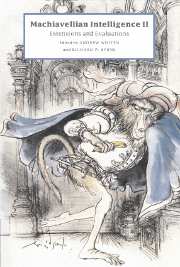Book contents
- Frontmatter
- Contents
- Contributors
- Preface
- 1 Machiavellian intelligence
- 2 Friendships, alliances, reciprocity and repair
- 3 Why Machiavellian intelligence may not be Machiavellian
- 4 Social intelligence and success: Don't be too clever in order to be smart
- 5 Minding the behaviour of deception
- 6 The Machiavellian mindreader
- 7 Exploiting the expertise of others
- 8 Primates' knowledge of their natural habitat: As indicated in foraging
- 9 Evolution of the social brain
- 10 The modulatory of social intelligence
- 11 The Technical Intelligence hypothesis: An additional evolutionary stimulus to intelligence?
- 12 Protean primates: The evolution of adaptive unpredictability in competition and courtship
- 13 Egalitarian behaviour and the evolution of political intelligence
- 14 Social intelligence and language: Another Rubicon
- Index
14 - Social intelligence and language: Another Rubicon
Published online by Cambridge University Press: 23 November 2009
- Frontmatter
- Contents
- Contributors
- Preface
- 1 Machiavellian intelligence
- 2 Friendships, alliances, reciprocity and repair
- 3 Why Machiavellian intelligence may not be Machiavellian
- 4 Social intelligence and success: Don't be too clever in order to be smart
- 5 Minding the behaviour of deception
- 6 The Machiavellian mindreader
- 7 Exploiting the expertise of others
- 8 Primates' knowledge of their natural habitat: As indicated in foraging
- 9 Evolution of the social brain
- 10 The modulatory of social intelligence
- 11 The Technical Intelligence hypothesis: An additional evolutionary stimulus to intelligence?
- 12 Protean primates: The evolution of adaptive unpredictability in competition and courtship
- 13 Egalitarian behaviour and the evolution of political intelligence
- 14 Social intelligence and language: Another Rubicon
- Index
Summary
Like the first volume of Machiavellian Intelligence this successor is concerned with the role of social intelligence in primate evolution. The editors note ‘three principal branch points’ in primate evolution at which selective pressures for intellectual change need to be identified, of which the Homo line is the last (Chapter 1). The Homo line is characterised by ‘massive brain enlargement, and extensive stone tool use, (see p. 14). My own chapter begins by looking briefly at questions raised by this astonishing trajectory from apes to Homo sapiens sapiens. If Machiavellian social intelligence can be traced from the strepsirhine line to its greater elaboration in apes, was it further refinement of this form of social intelligence by which the apes bootstrapped themselves to fully human intelligence? If so, were there no new characteristics linked to the hominid transition? The editors suggest that this may have occurred as a legacy from ape intelligence, or as a consequence of ‘social bias’ in solving problems of survival in the changing conditions of hominid ecology. Another possibility they note is the ‘specific development of a social module or modules, independent from other modules used for non-social tasks’ (see p. 14).
What form might a ‘social bias’ have taken? How would a ‘social module’ operate? Both would seem to involve some sort of linking of cognitive processes and social interaction. Indeed primate social intelligence can be seen as the progressively effective cognitive mapping of the interdependency of own and others' actions. Here primate cognitive mapping of feeding territories (Milton, 1988) may have been a precurser of the cognitive modelling ofcontingent interaction.
- Type
- Chapter
- Information
- Machiavellian Intelligence IIExtensions and Evaluations, pp. 365 - 396Publisher: Cambridge University PressPrint publication year: 1997
- 2
- Cited by



